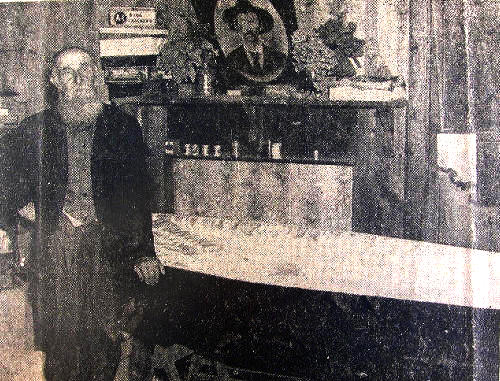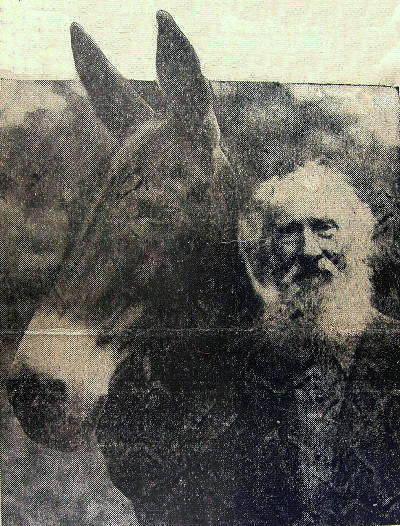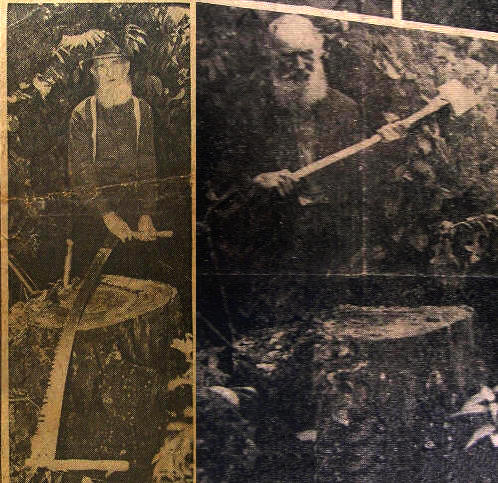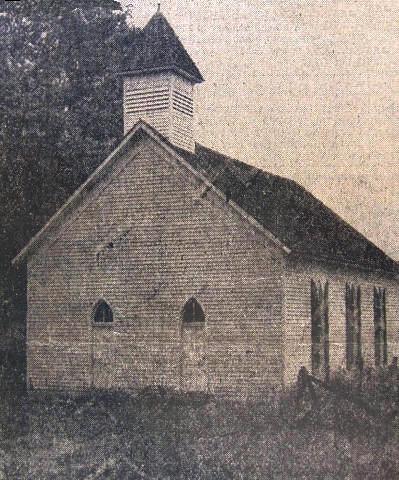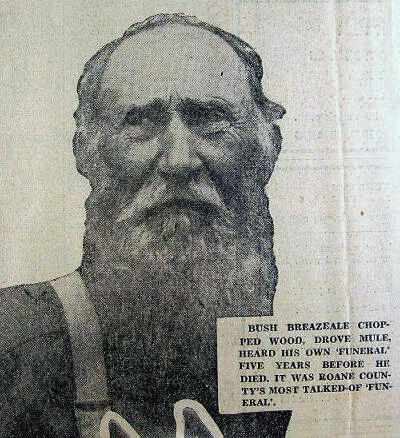During the last years of his life, Mr. Breazeale made many other personal appearances in theaters and was featured on a "Believe It or Not!" program of Robert Ripley.
On February 9, 1943, the "living corpse" actually did die. Then a real funeral was held for him.
The funeral five years before had really been almost like a rehearsal, for the real one followed much the same pattern.
It was held at 2 p. m. on a Sunday afternoon at the Cave Creek Baptist Church. Quinn's Funeral Home had charge, just as they did in the rehearsal. Burial was in the Cave Creek Cemetery.
But the huge crowds and the publicity were gone. Mr. Breazeale had his quiet funeral service at last.
Research notes and comments on the Betty Magee article.
There are some important discreptancies woven through Ms. Magee's article, if the eyewitness accounts of the background of this story are to be believed. I have made some notes where her statements have differed significantly from other credible
sources, sometimes multiple credible sources.
To settle the apparently common misconception about the lumber Uncle Bush used to build his coffin. He cut down one tree and had it milled into boards. From those boards, and he would have had far more than he needed to build one casket, he
selected the heartwood, the best cuts of lumber, and crafted them into his casket. He did not cut down multiple trees for this
purpose. This whole story started with a discussion about a large black walnut tree near Uncle Bush's cabin and what plan he
had for the tree. The one tree is at the heart of the story.
The second common misconception that I want to dispel is that Uncle Bush lived alone most of his life. He did not live alone. He simply did not marry. He lived with his parents until they died. Then with a sister. Finally with a nephew. He was not a
loner or a hermit. He had many friends and was well known in his community. He was a member of Cave Creek Baptist Church
and had been for 30 or 35 years.
The third common misconception is a relatively minor one compared to some of the others, but in the interest of accuracy, an important one. Many of the sources I have seen, including this one, refer to Uncle Bush's death as five years after the
funeral. I want to bring out the fact that he died in February, 1943, four years and seven months after the funeral. That is
almost five months shy of five years.
Her narrative states that Uncle Bush got charged with murder, joined the church, and then was acquitted of the crime. She obviously does not know the story, at all. Bush got into trouble, spent much of 1892 in jail, then was acquitted of the crime.
That all took place when Uncle Bush was 27 years old. He didn't join the church until he was in his early fortys, ten or twelve
years later.
Ms. Magee assumes that Bush's idea of having his funeral early brewed for years under the surface, but my research and the feeling I got from the eyewitness accounts and interviews with Bush was that he had never thought of the idea until he was
seventy-three years old and it was brought out in a conversation with Augustus Summers. He had planned to build his own
coffin, but there is no indication that he ever had a prior thought of having his funeral before he died. It was something that
he and Mr. Summers agreed would be a sound idea. Bush decided the time was right and that he would do it. Mr. Summers was
a big help with communications and advertising, otherwise it never would have been the event it was.
The point she makes, about the funeral procession stopping in front of the tent so the pallbearers could extract the casket and carry it to it's place under the tent, is not accurate. The funeral procession was bogged down on the road as the highway
patrol was trying to clear a way for the hearse. The hearse, with Uncle Bush inside, was already thirty minutes behind
schedule. When the hearse got to within sight of the tent, Frank Quinn, the undertaker of Quinn's Funeral Home, in charge of
the procession proper, ordered the pallbearers, some of whom were not present due to the traffic, to extract the casket from
the hearse and carry it to the tent. You got the impression they were some distance away from the tent. Uncle Bush strolled
along behind and received much attention from the crowd.
"A vocal solo was given by Fred Berry, of Knoxville." Correct! Remember the weak reference to 'a Knoxville funeral home' that lined and fitted the casket to get it ready to serve it's function. That was the Berry Funeral Home and the undertaker there was Fred Berry. It seems Mr. Berry was playing a big role in this story to get such an off-hand mention. The same goes for Augustus Summers and Frank Quinn.
"Mr. Breazeale and his homemade coffin were featured at Harriman's Fourth of July celebration the same year as the rehearsal funeral." From this statement one gets the feeling that there was a huge gap in time before this took place. Perhaps
months. The funeral was on June 26, so it was exactly 9 days after the funeral when Bush was the featured celebrity of the
July Fourth celebration in Harriman. For the two events to have been so close together, it just seemed like a very misleading
way to phrase the sentence, if one was aware of that fact.
Another point is one that I think is a misconception about Uncle Bush's motive for having the funeral. I have read in several places, including Ms. Magee's article, the reference to the funeral as a 'rehersal' funeral. I have never gotten the impression from any of the eyewitness accounts or quotations from Uncle Bush that he ever thought of this funeral as a rehersal. From
the first thought of it, all the way to it's completion, it was never referred to by any of the principal players as a rehersal. It
was to be his funeral, held early so he could hear what was said about him. That was a big concern of his.
Another term she uses, that I feel is based on 'conjecture of the writer' (writer's tendency to draw certain conclusions that may not be entirely accurate, in a best effort to write an interesting article), is the term 'celebration' funeral. The impression one gets from her writing is that Bush set out to have a rousing good time with his casket and the attention he was getting.
Nothing could have been further from the truth. The public that arrived for the funeral turned the event into a festive
occasion with the interest, enthusiasm, and humor they brought with them. Uncle Bush never had in mind anything but a small,
solemn, sincere affair in which he could hear his own eulogy and know that it was to his satisfaction. I believe he would have
been content with just that, but, due to publicity, it became something he never could have conceived of.
Next, she declares that when he did die, a "real funeral was held for him. The funeral five years earlier had really been almost like a rehersal, for the real one followed much the same pattern." Then she lists the three similarities to the 1938
funeral: It was held at two o'clock in the afternoon on a Sunday, at the same church, with the same funeral home in charge.
She leaves the reader with the impression that a duplicate funeral service was held. She obviously did not know what actually
happened. Yes, those three factors were the same, but Uncle Bush left specific instructions as to the interment service he
wanted. He was to lie in state for one hour at the gravesite, he was to be buried in his black walnut casket, and there was to
be no eulogy, songs, or preaching. He wanted a simple interment service. No more. That was exactly what he received,
according to the eyewitness accounts I read.
The last comment I have about Ms. Magee's article is that there is a serious paucity of pictures. There is not a single picture of the funeral on the day it occurred. There is a picture of a church building, without even one person in the picture, and it
is entirely possible that it is not even the Cave Creek Baptist Church. All-in-all, it appears that this article was just thrown
together without much thought, planning or research. Perhaps she was working against a deadline. To her credit, she did bring
certain things to light that I have not seen in any other source. I did not know that the NEA picture service played a role in
the publicity of the event. I didn't know that it was the Tennessee Theatre in which Uncle Bush saw his first talking movie.
I also didn't know that it was the Princess Theatre where he made personal appearances during the July Fourth celebration in
Harriman.
|
